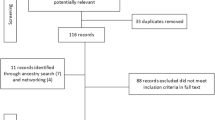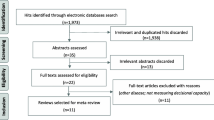Abstract
With the growing complexity of treatment decisions made at presentation to a psychiatric emergency room (PER) and the increasing influence of managed care on the decision-making process, it is increasingly important to establish a new and more sophisticated research agenda for studying PER decision making. The main goal of this paper is to propose a comprehensive conceptual model of the PER decision-making process that will facilitate active pursuit of such a research agenda. The proposed model presents both traditional and emerging elements of the PER decision-making process (i.e., determinants, mediating mechanisms, and outcomes) and explicates the nature of the relationships among them at different levels of analysis. The model's theoretical and empirical implications for future research are discussed and suggestions are made as to the research designs and methods needed to pursue this agenda.
Similar content being viewed by others
REFERENCES
Aday, L. A., & Awe, W.C. (1997). Health service utilization models. In D. S. Gochman (Ed.), Handbook of health behavior research I: Personal and social determinants (pp. 153–172). New York: Plenum Press.
Allen, M. H. (1999). Level 1 psychiatric emergency services. The Psychiatric Clinics of North America, 22(4), 713–734.
Allison, P. D. (1996). Survival analysis using the SAS system: A practical guide. Cary, NC: SAS Institute.
Andersen, R., & Newman, J. (1973). Societal and individual determinants of medical care utilization in the United States. Milbank Memorial Fund Quarterly Journal, 51, 95–124.
Anderson, J., & Eppard, J. (1995). Clinical decision making during assessment for involuntary psychiatric admission. Psychiatric Services, 46(7), 727–728.
Baxter, S., Chodorkoff, B., & Underhill, R. (1968). Psychiatric emergencies: Dispositional determinants and the validity of the decision to admit. American Journal of Psychiatry, 124(11), 1542–1548.
Benander, M. K. (1996). Psychiatric emergency room interventions and aspects of patient care that increase patient adherence to referrals for outpatient treatment. Unpublished dissertation, University of Massachusetts.
Binning, R. R. (1998). Patient characteristics affecting compliance with follow-up after psychiatric emergency room visits. Dissertation Abstracts International: Section B: The Sciences & Engineering, 59(8-B), 4456.
Breslow, R. E., Erickson, B. J., & Cavanaugh, K. C. (2000). The psychiatric emergency service: Where we've been and where we're going. Psychiatric Quarterly, 71(2), 101–121.
Claassen, C. A., Hughes, C.W., Gilfillan, S., McIntire, D., Roose, A., Lumpkin, M., & Rush, A. J. (2000). Toward a redefinition of psychiatric emergency. Health Services Research, 35(3), 735–754.
Craig, T. J., Huffine, C. L., & Brooks, M. (1974). Completion of referral to psychiatric services by inner city residents. Archives of General Psychiatry, 31, 353–357.
Cross, C.D. (2000). Introduction. Special section: Psychiatric emergency services. Psychiatric Quarterly, 71(2), 97–99.
D'Aunno, T. A. (1997). Linking substance abuse treatment and primary health care. In J. A. Egertson, D. M. Fox, & A. I. Leshman (Eds.),Treating Drug Users Effectively (pp. 311–351). Malden, MA: Blackwell.
D'Aunno, T. A., & Vaughn, T. E. (1995). An organizational analysis of service patterns in outpatient drug abuse treatment. Journal of Substance Abuse, 7, 27–42.
DiMaggio, P. J., & Powell, W. W. (1983). The Iron Cage revisited: Institutional isomophism and collective rationality in organizational fields. American Sociological Review, 48, 147–160.
Engleman, N. B., Jobes, D. A., Berman, A. L., & Langbein, L. I. (1998). Clinicians' decision making about involuntary commitment. Psychiatric Services, 49(7), 941–945.
Friedmann, P.D., D'Aunno, T. A., Jin, L., & Alexander, J.A. (2000). Medical and psychosocial services in drug abuse treatment:Do stronger linkages promote client utilization. Health Services Research, 35(2), 443–465.
Gerson, S., & Bassuk, E. (1980). Psychiatric emergencies: An overview. American Journal of Psychiatry, 137(1), 1–11.
Holmes, W., & Solomon, P. (1980). Criteria used in first admissions and readmissions to psychiatric hospitals. Social Science Medicine, 14A, 55–59.
Holmes, W., & Solomon, P. (1981). Organizational and client influences on psychiatric admissions. Psychiatry, 44, 201–209.
Hoyle, R.H. (Ed.). (1995). Structural equation modeling: Concepts,issues and applications. California: Sage publications.
Lidz, C. W., Coontz, P. D., & Mulvey, E. P. (2000). The “passthrough” model of psychiatric emergency room assessment. International Journal of Law and Psychiatry, 23(1), 43–51.
Marson, D. C., McGovern, M. P., & Pomp, H. C. (1988). Psychiatric decision making in the emergency room:Aresearch overview. American Journal of Psychiatry, 145(8), 918–925.
McCleary, R., & Hay, R. A. (1980). Applied time series analysis for the social sciences. California: Sage Publications.
McGlynn, E. A. (1996). Domains of Study and Methodological Challenges. In L. I. Sederer & B. Dickey (Eds.), Outcomes Assessment in Clinical Practice (pp. 19–24). Baltimore: Williams & Wilkins.
McGlynn, E. A., Norquist, G. S., Wells, K. B., Sullivan, G., & Liberman, R. P. (1988). Quality-of-care research in mental health: Responding to the challenge. Inquiry, 25, 157–70.
Mendel, W. M., & Rapport, S. (1969). Determinants of the decision for psychiatric hospitalization. Archives of General Psychiatry, 20, 321–328.
Meyer, G.W., & Rowan, B. (1977). Institutionalized organizations: Formal structure as myth and ceremony. American Journal of Sociology, 83, 340–363.
Meyerson, A. T., Moss, J. Z., Belville, R., & Smith, H. (1979). Influence of experience on major clinical decisions. Archives of General Psychiatry, 36, 423–427.
Olfson, M., & Goldman, H. H. (1996). Mental health services research. In W. R. Breakey (Ed.), Integrated Mental Health Services. Modern Community Psychiatry (pp. 103–119). New York: Oxford University Press.
Pescosolido, B. A., Gardner, C. B., & Lubell, K. M. (1998). How people get into mental health services: Stories of choice, coercion, and “muddling through” from “first timers.” Social Science Medicine, 46(2), 275–286.
Rabinowitz, J., Slyuzberg, M., Salamon, I., Dupler, S., Kennedy, R. S., & Steinmuller, R. (Eds.). (1995). A method for understanding admission decision making in a psychiatric emergency room. Psychiatric Services, 46(10), 1055–1060.
Ratzan, S.C., Payne, J.G., & Bishop, C. (1996).The status and scope of health communication. Journal of Health Communication, 1(1), 25–42.
Rothbard, A. B., & Schinnar, A. P. (1996). Community determinants of psychiatric hospitalization and length of stay. Socio-Economic Planning Sciences, 30(1), 27–38.
Salzer, M. S., Nixon, C. T., Schut, L. J. A., Karver, M. S., & Bickman, L. (1997). Validating quality Indicators. Quality as relationship between structure, process, and outcome. Evaluation Review, 21(3), 292–309.
Samet, J. H., Saitz, R., & Larson, M. J. (1996). A case for enhanced linkage of substance abusers to primary medical care. Substance Abuse, 17(4), 181–199.
Schuster, J. M. (1995). Frustration or opportunity? The impact of managed care on emergency psychiatry. In M. H. Allen (Ed.), The Growth and Specialization of Emergency Psychiatry (Vol. 67, pp. 101–108). San Francisco: Jossey Bass.
Scott, R. (1992). Organizations: Rational, natural, and open systems. (3rd ed.). Englewood Cliffs, NJ: Prentice Hall.
Segal, S., Egley, L., Watson, M. A., & Goldfinger, S.M. (1995). The quality of psychiatric emergency evaluations and patient outcomes in county hospitals. American Journal of Public Health, 85(10), 1429–1431.
Segal, S., Watson, M. A., Goldfinger, S. M., & Averbuck, D. S. (1988). Civil commitment in the psychiatric emergency room III. Disposition as a function of mental disorder and dangerousness indicators. Archives of General Psychiatry, 45, 759–763.
Segal, S. P., Watson, M. A., & Akutsu, P. D. (1996). Quality of Care and Use of Less Restrictive Alternatives in the Psychiatric Emergency Service. Psychiatric Services, 47(6), 623–627.
Slagg, N.B. (1993). Characteristics of emergency room patients that predict hospitalization or disposition to alternative treatments. Hospital and Community Psychiatry, 44(3), 252–256.
Sofaer, S. (1999). Qualitative methods:What are they and why use them. Health Services Research, 34(5), 1101–1118.
Solomon, P. (1981). The admissions process in two state psychiatric hospitals. Hospital and Community Psychiatry, 32(6), 405–408.
Solomon, P., & Gordon, B. (1986). The psychiatric emergency room and follow-up services in the community. Psychiatric Quarterly, 58(2), 119–127.
Solomon, P., & Gordon, B. (1987). Follow-up of outpatient referrals from a psychiatric emergency room. Social Work in Health Care, 13(1), 57–67.
Thornicroft, G., & Bebbington, P. (1996). Quantitative methods in the evaluation of community mental health services. In W. R. Breakey (Ed.), Integrated Mental Health Services (pp. 120–138). Oxford: Oxford University Press.
Turner, J. C. (1991). Social influence. California: Cole Publishing.
Watson, M. A., Segal, S. P., & Newhill, C. E. (1993). Police referral to psychiatric emergency services and its effect on disposition decisions. Hospital and Community Psychiatry, 44(11), 1085–1090.
Way, B. B., Evans, M. E., & Banks, S. M. (1992). Factors predicting referral to inpatient or outpatient treatment from psychiatric emergency services. Hospital and Community Psychiatry, 43(7), 703–708
Weick, K. E. (1969). The social psychology of organizing. (2nd ed.). Massachusetts: AddisonWesley.
Wells, K. B., & Brook, R. H. (1989). The quality of mental health services: Past, present, and future. In C. A. Taube, D. Mechanic, & A.A. Hohmann (Eds.), The Future of Mental Health Services Research. Washington, D.C.: Government Printing Office.
Author information
Authors and Affiliations
Corresponding author
Rights and permissions
About this article
Cite this article
Blitz, C.L., Solomon, P.L. & Feinberg, M. Establishing a New Research Agenda for Studying Psychiatric Emergency Room Treatment Decisions. Ment Health Serv Res 3, 25–34 (2001). https://doi.org/10.1023/A:1010108418256
Issue Date:
DOI: https://doi.org/10.1023/A:1010108418256




